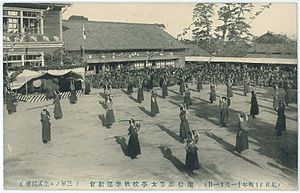Naginata facts for kids
The naginata is a Japanese weapon. It has a long wooden handle, called a shaft, and a curved blade. The word "naginata" means "mowing down sword" or "reaping sword."
The blade of a naginata can be about 1 to 3 feet long. It looks like a leaf, with a curve towards its tip. This blade is strongly attached to a long wooden shaft, which is usually between 6 and 9 feet long. The part of the blade that goes into the handle is almost as long as the blade itself. This makes sure the blade stays very secure. The shaft also has a sharp metal cap at its end, called an ishizuki. This cap could be used to pierce through armor.
Contents
History of the Naginata
Some people believe the naginata was first used in China around 3 BC. In Japan, it was first mentioned in a book called the Kojiki in 712 AD. It also appeared in paintings of battles from the Tengyo Insurrection in 936 AD.
The naginata became more common during the Nara period (around 710-784 AD). By the 11th century, it was widely used in battles.
Who Used the Naginata?
- Warrior-monks: These monks used the naginata to defend their temples from attackers. By the 1400s, temples were not attacked as much, so monks used it less.
- Samurai: Samurai warriors used the naginata when fighting many enemies at once or when they were on horseback. Sometimes, younger samurai or archers also used it.
- Samurai Women: By the Edo period (1603-1867), the naginata was no longer used much in real combat. Instead, it became a special weapon for samurai women. They trained with it for self-defense, to protect their children, and to develop good character. Some samurai families even hung naginata in important places in their homes. It was sometimes given as a gift to a bride.
How the Naginata Was Made
There are three main ideas about how the naginata was first created.
Farming Tool Theory
One popular idea is that the naginata came from a farming tool. Farmers used long sticks with sharp stones attached to the end to chop things. This was around 3 BC. Later, metal pieces replaced the stones. When their farms were attacked, farmers used these tools to defend themselves. They found them to be good weapons, and so they were improved over time.
Chinese Influence Theory
Another idea is that Chinese halberds (a type of pole weapon) were brought to Japan. This might have happened during early travels around 200 BC. Many weapon experts think that even if the Chinese invented the basic idea, the Japanese made it much better.
Direct Weapon Theory
A third theory says the naginata developed directly as a weapon. The first naginata blades were made of bronze. Later, when steel was discovered, it made the weapon even stronger. This theory suggests the naginata was developed much later than when metal first arrived in Japan from other parts of Asia (around 200 BC).
Naginata in Battle
The naginata was mostly used by foot soldiers. The samurai elite often preferred the katana sword. There is also proof that Sohei (Buddhist warrior monks) used the naginata.
A Woman's Weapon
The naginata was also seen as a weapon for women. Its long shaft gave women a big advantage. It allowed them to keep an enemy at a safe distance. One of Japan's most famous women warriors was Itagaki. Her naginata skills were said to be better than even the most skilled samurai. During the Edo period (1600-1800 AD), Japanese girls were taught how to use the naginata by age 18.
Against Horsemen
The naginata was very effective against horsemen. Because of its length, it was used with sweeping and circular movements, not like a traditional sword. To use it well, a person had to quickly change their hand positions along the shaft.
In cavalry battles, the naginata was like medieval spears. Foot soldiers used it to cut the legs of horses. Once the horse fell, the rider was easier to defeat.
Naginata as a Martial Art
Today, Naginata is also a Japanese martial art. It is practiced by men, women, and children. This fighting style has roots going back over 1,000 years. The naginata weapon is very good against both riders and foot soldiers. It is well-balanced, which makes it possible for women and children to use it. The way of fighting with a naginata is very graceful, with circular swinging movements.
Modern Naginata training teaches respect, patience, good manners, self-confidence, and self-control. Practicing Naginata helps people learn perfect control and balanced body movements. This art needs discipline and focus to achieve graceful and effective movements. It also helps build a person's character by teaching a strong moral code based on honor.
Modern Naginata Styles
The shape of the modern naginata has changed over time. It now looks more like a European halberd or glaive. The blade is more curved, like a scimitar. After the Meiji Restoration (1868-1912), the value of martial arts dropped. But Naginata survived and became part of the public school system during the Showa period (1912-1926).
Different ways of handling the naginata led to famous schools (ryu). The Atarashii Naginata School and Jikishin-kage ryu are the most popular. Other known schools include Tendo ryu and Toda Ha Buko ryu. Even with their differences, all these schools aim to teach the traditional manners and spiritual training of a person.
Images for kids
-
Mounting for naginata, Edo period
-
Tomoe Gozen, an "onna-musha", wields a naginata on horseback.
-
Antique naginata blade, Tokyo National Museum
-
A naginata made in the Kamakura period.
-
The onna-musha Tomoe Gozen on horseback with a naginata.
-
A samurai uses a naginata, Yoshitoshi
-
Samurai Takayama Ukon with a naginata. Woodcut Utagawa Yoshiyuku (1867)
-
A ronin with a katana and naginata.
See also
 In Spanish: Naginata para niños
In Spanish: Naginata para niños














